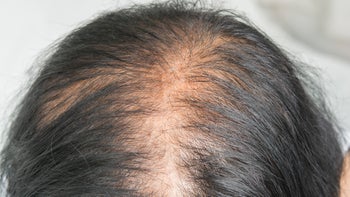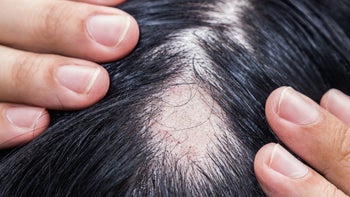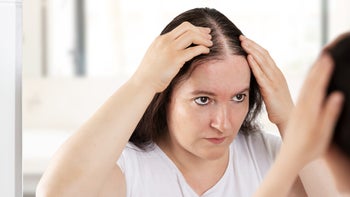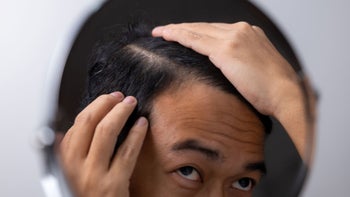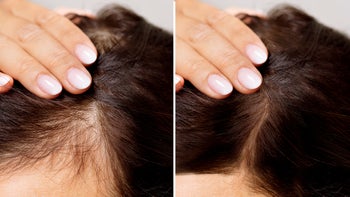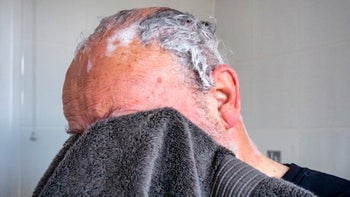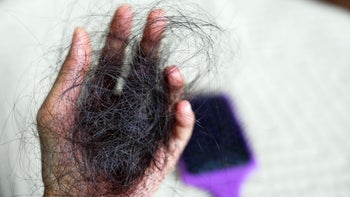
6 Shampoos and Treatments That May Cause Hair Loss: Brands and Ingredients to Avoid
Key takeaways:
Shampoos contain many different ingredients that do more than just clean hair.
Some ingredients, like formaldehyde, have been linked to hair loss. But there isn’t definitive evidence proving this.
There are steps you can take to lower your risk of hair loss and get healthy hair.
Table of contents

You may have heard that certain shampoo ingredients can cause hair loss. But which ingredients are they, and how much of it is true? Should you be worried about the shampoo you’re using?
We’ll review common ingredients in shampoos, chemicals and products that may be linked to hair loss, and steps you can take to lower your risk of losing or damaging your hair.
Can shampoo ingredients cause hair loss?
It’s possible. The amount will depend on the type of shampoo you use. Shampoos are mainly used to clean your scalp and hair, but they also do other important things, like:
Provide cosmetic benefits (pleasing smell and feel)
Remove previous products from your hair
Avoid skin irritation
Address hair or scalp conditions (like oily hair or dandruff)
Search and compare options
To accomplish all of this, some shampoos can have up to 30 different ingredients, including various chemicals that help with the stability and presentability of the shampoo.
Each of these ingredients has a specific purpose. But, over time, some of them may lead to different problems and health concerns. If research reveals more about certain ingredients and their negative health effects, they may be removed from cosmetic products.
Let’s start by reviewing common shampoo ingredients and then ones that may possibly be linked to hair loss.
Could your medications be causing hair loss? Learn about twelve common medications that cause hair thinning.
COVID-19 and other illnesses can cause hair loss. Here, one woman shares her experience.
Looking for natural ways to support your hair growth? From scalp massage to essential oils, explore eight natural remedies for healthy hair.
Common shampoo ingredients to know about
Here are some basic ingredients you may find in your shampoo:
Detergents: These are the primary cleansers (usually surfactants) that help remove dirt and oil. Common ones include different sulfates, like sodium lauryl sulfate and sodium laureth sulfate.
Conditioners: These help make hair manageable and glossy with decreased static. Examples in shampoo include propylene glycol and dimethicone.
Thickeners and opacifiers: These make the shampoo feel thicker and look more appealing, but they don’t have an effect on cleansing. Examples include glycol distearate and sodium chloride.
Sequestering agents: These help prevent soap scum from forming. Ethylenediaminetetra-acetic acid is an example.
Preservatives: These keep germs from growing and help the shampoo last. Common ones include parabens and formaldehyde releasers like 1,3-dimethylol-5, 5-dimethyl (DMDM) hydantoin, and quaternium-15.
Special additives: These include things like chemical sunscreens and vitamins.
Formaldehyde: Formaldehyde or formaldehyde releasers can be found in some keratin hair-smoothing treatments, like the “Brazilian blowout.” These ingredients are not safe for your hair and scalp.
Shampoos and hair products linked to hair loss lawsuits
There have been many complaints about certain ingredients or products causing hair loss, but these associations haven’t been proven definitively. Here’s a list of shampoos that have caused hair loss lawsuits, including the main concerns associated with the products.
1. Unilever TRESemmé keratin shampoo and conditioners
Several people have reported hair loss and serious scalp burns after using TRESemmé keratin products with DMDM hydantoin. Class-action lawsuits have been filed in different states against Unilever for these products. And Unilever (which recalled the product in question) settled a previous, similar lawsuit.
2. Johnson & Johnson OGX shampoo
A class-action lawsuit has been filed against Johnson & Johnson for their OGX shampoo and several other hair products. Many people have reported hair loss and scalp irritation from using OGX products containing DMDM hydantoin.
3. Straight Arrow Products Mane ’n Tail shampoo and conditioners
People have reported scalp irritation and hair loss (including bald patches) after using Mane ’n Tail products with DMDM hydantoin. A class-action lawsuit has been filed against Straight Arrow Products for using formaldehyde releasers in several of its products.
4. WEN hair products
Many people reported hair loss after using certain WEN hair products. Class-action lawsuits were filed against the manufacturers of WEN, and a settlement was reached. The FDA had previously launched an investigation into these products. It’s not known which specific ingredients potentially caused these reactions, and the investigation is ongoing.
5. DevaCurl hair products
Several lawsuits alleged that certain DevaCurl products caused hair loss, scalp irritation, and hair breakage. These lawsuits have been combined, and mediation has started.
Learning about other people’s experiences with specific products can be informative, but keep in mind that certain ingredients may affect people differently. And remember that a settlement doesn’t mean that a company admitted their product was at fault.
6. Brazilian blowouts
Some salon-based keratin hair-smoothing treatments (also called a “Brazilian blowout”) have formaldehyde or formaldehyde releasers in them (like DMDM hydantoin). Many people have reported hair loss and scalp irritation after using these products. The FDA issued a consumer update about this but has yet to ban these products.
Class-action lawsuits have been filed against products with DMDM hydantoin for possible hair loss and scalp irritation
Can other hair products or practices also cause hair loss?
Some styling products and hairstyles have been linked to traction alopecia, a type of permanent hair loss. This happens when pulling causes strands of hair to break or fall out, which can lead to permanent damage to hair follicles.
Here are some examples of tight hairstyles associated with hair loss:
Buns and ponytails that are tightly pulled
Cornrows
Dreadlocks
Tightly braided hair
Hair extensions or weaves
Keep in mind that it’s OK to wear these styles from time to time. But doing so every day can increase your risk of losing hair.
Some chemical hair treatments, like chemical straightening, have been linked to hair loss when used along with tight hairstyles.
Can sulfates cause hair loss?
You have probably heard a lot about sulfate-free shampoos. Some forms of sulfates — like sodium lauryl sulfate — can cause significant scalp irritation, especially in people with sensitive skin.
If sulfates cause enough irritation, they may contribute to hair damage and hair thinning in some people. If you have sensitive skin, you may benefit from trying a sulfate-free shampoo.
Which other factors or habits can contribute to hair loss?
Other aspects of your life can contribute to thinning hair, such as:
Repeated trauma to your hair can also cause hair breakage, called acquired trichorrhexis nodosa. This can happen from things like excessive brushing or the use of chemicals or heat.
Emotional or physiological stress (like an illness, surgery, or childbirth) can cause a type of hair loss called telogen effluvium. This usually happens 3 to 5 months after the stressor, and hair grows back to normal in most people.
Are there ways to regain hair you’ve lost?
It depends on the type of hair loss. If your hair follicles are scarred (scarring alopecia), they may be too damaged to regrow hair. This can happen from some chemicals, hair trauma, and certain medical conditions.
Hair loss that doesn’t scar (non-scarring alopecia) can happen for different reasons, like natural aging and certain medical conditions. Depending on the situation, this type of hair loss can be reversible.
If you’re losing hair — for any reason — it’s important to see a dermatologist to find out the cause and possibly start treatment.
What you can do for healthier hair
How you wash your hair and the products you use can affect the health of your hair. Here are some tips to get healthy hair:
How often you wash your hair depends on how much oil your scalp makes. An oily scalp may need to be washed every day. But less washing may be needed with less oil.
When washing your hair, focus on cleaning your scalp, not the length of your hair, as this can make it dull and coarse.
Choose products specific for your hair type (like color-treated hair). A sulfate-free shampoo may also help if you have sensitive skin or have scalp irritation.
Protect your hair when swimming.
Minimize things that can damage your hair, like coloring, blow-drying, and curling.
Hair-loss shampoos that can help regrow hair
In general, most hair-loss shampoos haven’t been proven to help regrow hair. One exception are shampoos that help block Malassezia, a common yeast on the scalp that may play a role in hair loss. Some studies show that these ingredients to fight dandruff may also be an effective option for hair growth:
Researchers are also studying new shampoo formulations, which show promising results as hair-loss treatments. If you notice that your hair is starting to thin, it’s best to get checked out by a dermatologist so you can start the most effective treatment possible.
The bottom line
Shampoos contain many different ingredients that help clean your hair and increase the stability of the shampoo. Some of these ingredients, like formaldehyde, have been linked to hair loss, although this hasn’t been proven definitively. Formaldehyde has been associated with other health problems, and it has been banned from some cosmetic products. There are steps you can take to lower your risk of hair loss and get healthy hair.
Why trust our experts?


References
Alessandrini, A., et al. (2016). All hairstyles are not created equal: What the dermatologist needs to know about black hairstyling practices and the risk of traction alopecia (TA). Journal of the American Academy of Dermatology.
Alessandrini, A., et al. (2016). Essential of hair care cosmetics. Cosmetics.
American Academy of Dermatology Association. (n.d.). 10 hair care tips that can damage your hair.
American Academy of Dermatology Association. (n.d.). Hairstyles that pull can lead to hair loss.
American Academy of Dermatology Association. (n.d.). Tips for healthy hair.
American Bar Association. (2019). How courts work.
American Skin Association. (n.d.). Alopecia.
Benesh, M. (2020). Timeline: The FDA’s failure to regulate ‘Brazilian blowout’ hair treatments. Environmental Working Group.
Berger, R. S., et al. (2003). The effects of minoxidil, 1% pyrithione zinc and a combination of both on hair density: A randomized controlled trial. British Journal of Dermatology.
Breast Cancer Prevention Partners. (2020). California first state to ban 24 toxic chemicals in personal care products and cosmetics.
Bucher, A. (2016). $10M Suave keratin infusion settlement affirmed by appeals court. Top Class Actions.
Bucher, A. (2016). WEN hair care products class action settlement. Top Class Actions.
ClassAction.org. (2022). DevaCurl maker hit with lawsuits over hair loss, scalp irritation.
Dias, M. F. R. G. (2016). Hair cosmetics: An overview. International Journal of Trichology.
D’Souza, P., et al. (2015). Shampoo and conditioners: What a dermatologist should know? Indian Journal of Dermatology.
Edwards, J. (2021). Johnson & Johnson OGX shampoo makes your hair fall out, class action lawsuit alleges. Top Class Actions.
Environmental Working Group. (2011). Adverse reactions and injuries.
Faber, S. (2017). Thousands of adults and children lost their hair. Will anything change? Environmental Working Group.
Feldman, P. R., et al. (2021). Safety and efficacy of ALRV5XR in men with androgenetic alopecia: A randomised, double-blinded, placebo-controlled clinical trial. EClinicalMedicine.
Henn, J. L. (2021). TRESemmé class action lawsuit claims shampoo causes hair loss, scalp burns. Top Class Actions.
Lawson, C. N., et al. (2017). Updates in the understanding and treatments of skin & hair disorders in women of color. International Journal of Women’s Dermatology.
Leon, S. (2012). Sulfate-free shampoo: Why you need to check your shampoo label, now. HuffPost.
Löffler, H., et al. (2003). Profile of irritant patch testing with detergents: Sodium lauryl sulfate, sodium laureth sulfate and alkyl polyglucoside. Contact Dermatitis.
MedlinePlus. (2023). Trichorrhexis nodosa.
Spicer, C., et al. (2022). Mane ‘n Tail class action alleging products cause hair loss, scalp irritation dismissed. Top Class Actions.
Top Class Actions. (2020). DevaCurl class action says products cause hair loss.
Trüeb, R. M., et al. (2018). Scalp condition impacts hair growth and retention via oxidative stress. International Journal of Trichology.
U.S. Food and Drug Administration. (2021). Formaldehyde in hair smoothing products: What you should know.


